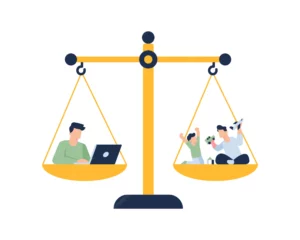Understanding and meeting the expectations of employees has become more crucial than ever. Managers need to understand what employees expect, even if they themselves started working in a different era. Let’s take a look at employee expectations and how employers can effectively meet them. Meeting these expectations not only benefits employees but also for the success of organizations. We’ll cover that later.
What does a Modern Employee look like?

- Tech-Savvy: A modern employee is comfortable using technology and digital tools to perform tasks efficiently. They leverage technology for communication, collaboration, and problem-solving, adapting quickly to new software and platforms as needed.
- Adaptive and Agile: In a fast-paced and ever-changing environment, a modern employee demonstrates adaptability and agility. They are open to learning new skills, embracing change, and adjusting their approach to meet evolving challenges and opportunities.
- Collaborative: Collaboration is essential in today’s interconnected workplace. A modern employee thrives in team environments, effectively communicating, sharing ideas, and working towards common goals. They understand the value of diverse perspectives and actively contribute to collective success.
- Continuous Learner: Learning is a lifelong journey, and a modern employee embraces opportunities for growth and development. People want to learn more to stay current in their field. They do this through training, informal experiences, or exploring on their own.
- Emotionally Intelligent: Emotional intelligence is valued in modern workplaces. It enables employees to navigate complex social dynamics, build strong relationships, and effectively manage interpersonal conflicts. A modern employee demonstrates empathy, self-awareness, and social skills in their interactions with colleagues and stakeholders.
- Purpose-Driven: Beyond financial rewards, a modern employee seeks meaning and purpose in their work. They are drawn to jobs that have the same beliefs and support causes they are passionate about. They want to make a positive impact on society or the environment through their work.
- Resilient: Resilience is a key trait of a modern employee, especially in the face of adversity or setbacks. They bounce back from challenges, learn from failures, and maintain a positive attitude in the pursuit of their goals.
Understanding Modern Employee Expectations
1. Flexible Work Arrangements
Modern employees cherish flexibility in their work setups. People really like the flexibility of working remotely, having flexible schedules, or working compressed weeks to fit their lifestyles. They appreciate being able to choose their own hours.
They enjoy the option of working longer hours on some days to have more days off. Employers who embrace and accommodate these preferences demonstrate trust in their employees’ get the work done.
2. Work-Life Balance

3. Opportunities for Growth and Development
Continuous learning and professional growth are high on most employees priorities today. Modern employees are eager to enhance their skills, take on new challenges, and advance in their careers. This is particularly true in industries where employees may not have a formal education.
4. Support for Mental Health and Wellness
The importance of mental health and well-being in the workplace cannot be overstated. Employees expect their employers to create a supportive work culture where mental health is prioritized and stigma is reduced. This is very different from the workplaces of 10-15 years ago, so often an area that employers struggle with.
Of course, with all of these in mind, employers need to consider how they can meet these expectations on a daily basis. Let’s look at some strategies they can try!
Strategies for Meeting Employee Expectations
1. Implement Flexible Work Policies

Flexible scheduling can be difficult to implement if you rely on manual employee scheduling methods. If you want to give your employees flexible options, think about using employee scheduling software. Here at Celayix, we give employers a range of options that can accommodate flexible scheduling;
- Self-scheduling lets employees choose shifts based on their own preferences, giving them control over their own work schedule.
- Shift bidding lets the scheduler decide, but also lets employees show interest in specific shifts. The scheduler can then give the shift to the best fit employee.
- Availability is the lowest level of autonomy you can provide to employees in terms of flexible scheduling. Essentially it allows employees to select the days they are available to work shifts. Schedulers can then use that information to build their schedule.
2. Foster a Culture of Work-Life Balance
Encourage employees to take breaks, use vacation time, and prioritize self-care to maintain a healthy work-life balance. Provide resources and support for managing stress and maintaining overall well-being, demonstrating a commitment to the holistic health of your workforce.
When it comes to shift workers, consider the shift patterns that you build your schedule on as these can impact work-life balance! Try to spread night shifts evenly, avoid clopening shifts, and listen to feedback from your employees in order to foster a healthy work life balance!
3. Invest in Professional Development

Where possible, hire internally for team lead and managerial roles to show your employees that you do want to help them progress in their career path.
4. Prioritize Mental Health and Wellness
Create a supportive environment where employees feel comfortable discussing mental health issues and seeking support when needed. Offer access to counseling services, promote mindfulness and stress management techniques, and encourage open dialogue about mental health to foster a culture of understanding and support.
As we briefly mentioned earlier, this emphasis on mental health is new to many managers and business owners. Educate yourself on how you can create a positive work culture and support employees struggling with mental health. When you take the time to educate yourself, you are actively showing your employees that you care about the issue at hand.
Impact of Employee Expectations on Recruitment and Retention
Understanding and meeting employee expectations not only contributes to the well-being and satisfaction of current employees but also play a significant role in recruitment and retention efforts. A gallup survey highlighted the 61% of employees highlighted work-life balance and wellbeing as very important when job hunting.
Organizations that prioritize employee satisfaction and well-being are more likely to attract top talent and retain valuable employees in the long run.
By creating a positive work environment that values flexibility, work-life balance, growth opportunities, and mental health support, employers can differentiate themselves as employers of choice and build a strong, motivated workforce. You’ll also likely experience lower employee turnover.
Meeting the expectations of today’s employees requires a proactive approach that addresses their evolving needs and priorities. Embrace flexibility, promote work-life balance, invest in professional development, and prioritize mental health and wellness. When you do this, you can create a supportive and inclusive workplace culture where employees feel valued, employee engagement is high, and your team is motivated to succeed.
Find a balance

It’s still important to lay our employer expectations, and tell employees expressly what is expected of them at work!
Ultimately, by meeting employee expectations, employers not only enhance the overall employee experience but also position themselves for long-term success in today’s competitive labor market. If you’d like to learn about how Celayix workforce management software can help you meet employee expectations, see a free live demo!




